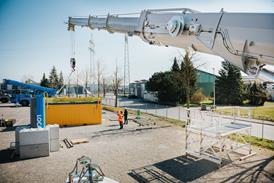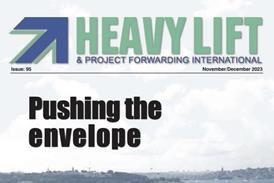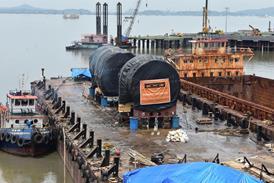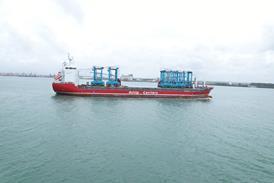Mariners have long sought viable east-west routes across the roof of the world as an alternative to traditional routes. Keith Wallis analyses how the Northern Sea Route is becoming an increasingly viable shipping lane.

Navigation through the Arctic via either Russia's northern seas or the Northwest Passage to link the Atlantic and Pacific oceans has been a holy grail for shipowners since the days of sail.
But only in the last eight years has climate change, coupled with the opening of the Arctic region to commercial development, made such navigation possible. Even so, climatic, geographic and political challenges remain with Russia's relations with the West likely to govern the future viability of the Northern Sea Route (NSR) to commercial shipping.
Russia's President, Vladimir Putin, speaking in his state of the nation address in March 2018, said that Russia wants to increase traffic along the NSR tenfold to 80 million tonnes by 2025.
Politicians in Beijing have also been championing the NSR, recently describing it as the 'Polar Silk Road'.
The NSR is officially defined by Russia's NSR Administration as running around 4,000 km from Cape Zhelaniya in the west through the Kara, Laptev and the East Siberian Sea to Cape Dezhnev in the east. But it is often depicted running further west to include Murmansk and even Kirkenes in northern Norway.
Norway's Centre for High North Logistics (CHNL), set up by Tschudi Shipping Company in colla-boration with the Norwegian Ministry of Foreign Affairs, shortens the sailing distance from Norway to China by more than 40 percent to 23 from 40 days via the usual route through the Suez Canal.
It is this time and fuel saving, together with the commensurate cut in carbon dioxide and other emissions, which makes the route so attractive. Typically fuel savings can amount to around USD200,000-USD250,000, based on current bunker prices, with a 4,000-tonne reduction in CO2 emissions for a one-way transit, according to CHNL figures. In tonnage terms, Bjorn Gunnarsson, managing director of the CHNL, said the cost of icebreaker assistance is roughly equal to the cost of using the Suez Canal.
Various heavy lift shipping lines have rapidly gained experience of sailing in the in-hospitable NSR, fuelled by the demands of constructing the USD27 billion Yamal LNG plant at Sabetta, on Russia's Yamal Peninsula. Marcel Pera, operations project manager at BigLift Shipping, claimed: "In 2015-2016 we were probably the biggest non-Russian user of the NSR. We have completed 32 full transits and at least another 25-30 partial transits - going in from one side to discharge cargo."
Most of this activity was to support construction of the Yamal LNG project, which is currently drawing to a close. "We brought a lot of modules to Yamal - both full modules and knocked down."
Most of the modules originated in China and were transported via the Suez Canal to a staging area at the Belgian port of Zeebrugge, before onward shipment. Alternatively, modules were shipped directly to Sabetta via the NSR.
BigLift has also made transit voyages, either in ballast or carrying cargoes such as equipment for power stations, Pera added.
There are limitations as to when transit along the NSR is viable. Andrey Demyanyuk, Murmansk branch manager of GAC Russia, said non-ice-class vessels can only navigate the route during the summer, usually from July to October or November.
"In winter, only ice-class vessels can navigate the NSR and icebreaker assistance is required, which means the route is not financially viable for some owners and operators," Demyanyuk said. With all of Russia's nuclear icebreakers operated by Rosatomflot, the average waiting time for icebreaker assistance is three to seven days.
Pavel Prikhodko, deputy general director at deugro Russia, said Rosatomflot operates four icebreakers with another kept in reserve. While the NSR is open all-year for ice-class vessels with icebreaker assistance. "In severe ice conditions, Rosatomflot may not take vessels with bulbous bows in a convoy because the bulb makes it difficult to release the vessel from ice", he said.
Cool deliveries

RedBox counts itself among the heavy lift operators that have sailed the NSR during winter. Its 28,500 dwt module carriers Audax and Pugnax can operate in temperatures down to -50 C, and were used to transport modules weighing up to 10,000 tonnes to the Yamal LNG project, deliveries that started in 2016.
"No one has ever delivered modules of this size in the middle of winter from Qingdao to Sabetta via the NSR. It is slow going and the ambient temperature is -25 C," said Philip Adkins, Red Box ceo.
The company had two 50,000 dwt semi-submersibles, Red Zed I and Red Zed II, which were the first vessels to transport prefabricated structures for Yamal LNG in summer 2015.
GAC's Demyanyuk added: "The time and distance-related cost savings offered by the NSR at certain times - whatever the vessel, and possibly more so for heavy lift ships given their size and weight - will diminish the further south the origin and/or destination are. Hong Kong- Rotterdam is reasonable while Hong Kong-Mediterranean probably is not."
Other challenges remain. Insurer Marsh highlighted the risks in its report, 'Arctic Shipping: Navigating the Risks and Opportunities' four years ago, which although supportive of the NSR also focused on the ship and crew risks associated with what was a fledgling market.
The Polar Code, introduced in January 2017, tackles some of these issues by mandating crew manning and training requirements to ensure crew are adequately experienced and requires vessels to have a Polar Ship Certificate (PSC) before obtaining permission to navigate the NSR. BigLift's Pera said: "All our captains and chief mates - 300-400 people - have completed an ice navigator course. We are working to get all of our vessels certified under the Polar Code."
Best practice
While the outlook for the NSR is potentially huge, given Russia's vast oil and gas resources in the Arctic, the biggest challenge to the NSR and heavy lift and project cargo shipping could be political.
As CHNL's Gunnarsson said, the development of energy, hydrocarbon and mineral resources will be the main driver for increased Arctic shipping in the coming decades.
"A large part of this resource potential is in the Eurasian Arctic at the western gateway of the NSR," he said in a presentation looking at future Arctic development.
But the US Treasury has currently torpedoed the USA's involvement in energy exploration and production in Russia and elsewhere, having imposed economic sanctions against Russia. As Demyanyuk highlighted: "GAC Russia's ability to undertake business is subject to prevailing sanctions."
This article is taken from HLPFI's March/April 2018 edition.















